|
|
|

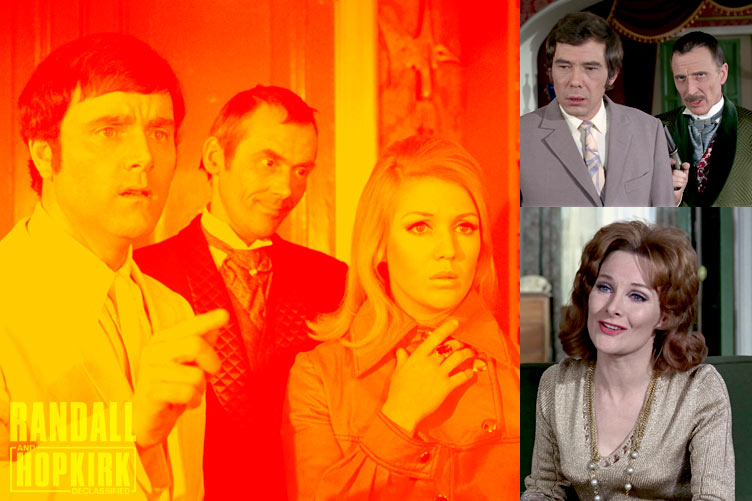
|
Images © ITV Studios, 1968 /
Composition @ Alan Hayes © 2024 |
|
Writer: Donald
James Director: Jeremy Summers |
|
ORIGINAL ITC SYNOPSIS |
|
Jean Hopkirk is the subject of some strange
psychic phenomena when efforts are made to
persuade her that her late husband is trying to
contact her. But why?

Not
surprisingly, Jean Hopkirk is worried and
frightened when a poltergeist apparently gets to
work in her apartment. Furniture and fittings
fly in all directions. She just manages to
telephone Jeff Randall before the 'phone is cut
off. Scared, she rushes from the house, and the
two interested onlookers watch with
satisfaction. They make a strange pair in their
old clothes which make them look like
traditional undertakers. They are, in fact,
brothers Henry Foster and George Foster.
They drive
off in their old-fashioned Rolls Royce as
Randall arrives. The fleeing Jean sees him and
tumbles into his car and tells him what has
happened, confiding: "I've had this feeling for
some time now... that Marty is trying to contact
me."
The ghostly
Marty Hopkirk overhears this, and make a
desperate appeal to Randall to assure her that
she is wrong. There's something more sinister
behind the strange happenings, but Jean is hard
to convince and quite unsuspecting when
approached by the Foster brothers with the offer
of a job, saying they are spiritualists with a
scientific approach. They want her to check out
anybody who applies to them.
The unseen
Marty accompanies her when she goes to their
house in the country, and even he is startled
when Henry Foster tells her that there is a
third spirit present - the spirit of her husband
and that he is trying to get a message through
to her. Nevertheless, he is still convinced that
they are phoney.
Jeff Randall
enlists the aid of an actress named Laura to
approach the Fosters in the guise of a wealthy
widow trying to trace a long lost son, and
persuades Jean to use her as a test case before
accepting the job. From Jean's point of view, it
seems to work out well: she will get commission
for introducing a client. But for Laura, the
outlook is bleak. The Fosters tell her that they
are going to kill her and that when she gets to
the other side, she is to contact Marty Hopkirk
and bring him back to speak to his wife...
It appears
that the Fosters have carried out their threat
when Randall and Hopkirk go to the old house to
investigate. They come to the conclusion that
the Fosters have some crazy idea of making new
spirits, and it looks as though Jeff will be the
next victim. And Jean is in increasing peril.
What lies
behind it all? The Fosters have some very
strange ideas. |
|
|
PRODUCTION & ARCHIVE |
Production
Code:
RH/DCW/4012
Filming Dates: Nov-Dec 1968
Production Completed: Mid-May 1969
Recording Format: 35mm Colour Film
Archive Holding: 35mm Colour Film |
|
UK REGIONAL PREMIERES |
Anglia: Mon 21 Jun 1971, 11.00pm
ATV: Fri 26 Sep 1969, 7.30pm (M)
Border: Fri 16 Jan 1970, 7.30pm (M)
Channel: Fri 26 Sep 1969, 7.30pm (M)
Grampian: Thur 26 Feb 1970,
7.00pm (M)
Granada: Fri 26 Sep 1969, 7.30pm (M)
Harlech: Fri 26 Sep 1969, 7.30pm (M)
LWT: Sun 5 Oct 1969,
7.25pm (M)
Scottish: Sat 26 Feb 1972,
11.10pm
Southern: Sun 12 Oct 1969,
7.25pm (M)
Tyne Tees: Sun 19 Jul 1970,
9.05pm
Ulster: Fri 26 Sep 1969, 7.30pm (M)
Westward: Fri 26 Sep 1969, 7.30pm (M)
Yorkshire: Fri 26 Sep 1969, 7.30pm (M) |
(M) =
Transmitted in Monochrome/Black and White
(M*) = Transmitted in B/W due to ITV Colour
Strike |
|
CHARACTERS & CAST |
Jeff
Randall
Marty Hopkirk
Jean Hopkirk
Henry Foster
George Foster
Laura Watson
Pawnbroker's Clerk
Man in Laundromat |
Mike Pratt
Kenneth Cope
Annette Andrι
Alfred Burke
Dudley Foster
Adrienne Corri
Noel Davis
Michael Rathborne |
|
STAND-INS |
Jeff Randall
Marty Hopkirk
Jean Hopkirk |
Harry Fielder
Dougie Lockyer
Tina Simmons |
|
STUNT DOUBLES |
|
Jeff Randall |
Rocky Taylor |
|
BLU-RAY
RESTORATION |
|
35mm Negative /
Magnetic soundtrack |
|
EPISODE SPECIAL FEATURES |
|
Production footage
(mute, 01:04), Photo Gallery |
|
ORIGINAL SOUNDTRACK |
|
Selections from the incidental
score for this episode have been issued on Randall
and Hopkirk (Deceased): Original Soundtrack by Edwin
Astley,
Network, 2008 |
|
|
PRODUCTION CREDITS |
|
An ITC Production
Writer Donald James
Series Theme / Musical Director Edwin Astley
Series Creator / Executive Story Consultant Dennis
Spooner
Creative Consultant - Cyril Frankel
Producer Monty Berman
Director Jeremy Summers |
|
Production
Supervisor Ronald Liles
Director of Photography Gerald Moss
Art Director Charles Bishop
Post Production Philip Aizlewood
Editor Harry Ledger
Production Manager Malcolm Christopher
2nd Unit Director Jack Lowin
2nd Unit Cameraman Frank Watts
Camera Operator Val Stewart
Assistant Director Michael Meighan
Continuity Sally Ball
Sound Recordists Denis Porter and Dennis
Whitlock
Sound Editor Guy Ambler
Music Editor Alan Willis
Casting Anthony Arnell
Set Dresser Sue Long
Construction Manager Bill Greene
Production Buyer Peter Dunlop
Scenic Artist A. J. Van Montagu
Stunt Co-ordinator Frank Maher
Make-Up Elizabeth Romanoff
Hairdresser Jeannette Freeman
Costume Supervisor Laura Nightingale
Sound Effects Cinesound
Titles Chambers + Partners
Made on
Location and at Associated British Elstree
Studios, London, England
© Copyright
ITC-INCORPORATED TELEVISION COMPANY LTD MCMLXVIII |
|
|
ALL
WORK AND NO PAY REVIEW |
|
By
the twelfth episode, Donald James was already
essentially a Randall and Hopkirk
veteran, having written just under half of the
episodes made, and although All Work and No Pay
is a fine entry in the series, it does unfortunately
score some own goals in its plotting. For starters,
the Fosters' plot barely holds water, their idea being
to kill someone so that they will act for them in the
afterlife, contacting spirits on their behalf. Surely
killing someone is a sure way to discourage
co-operation, even in the spirit world... Also, the
Fosters seem to fall rather conveniently for Laura's
trick of swimming naked across the lake, and where
did she find that newspaper to cover her modesty?
My last point is not made in any great seriousness,
and of course the presence of the newspaper provides a
great one-liner from Marty, "You don't want to believe
everything you see in a newspaper, Jeff." There is
however, also the question of how the Fosters'
manufacture their poltergeist happenings, which appear
to be achieved via electronics and radio waves, but
there is no attempt to give the viewer an explanation.
It's one of several narrative weaknesses in this
episode that the viewer has to overlook really, and
it's not actually that difficult to do so, as the
episode is superbly directed by Jeremy Summers, and
features a small but superb guest cast. Alfred Burke
and Dudley Foster as the episode's main protagonists
are a match for almost anyone in the series, and both clearly
had a ball playing their characters. Adrienne Corri,
another well-respected performer, turns in a memorable
performance as Laura Watson, a character that really
could have done with making a return appearance. In
all, a highly entertaining episode that at times
eschews narrative logic but which delivers in
abundance in all other areas. |
|
|
ALL WORK AND NO PAY DECLASSIFIED |
-
Pre-Titles Teaser...
On a residential street late at night, a distinctive
vintage Bentley tourer approaches, its yellow
headlights scything through the gloom. It turns
right and shortly afterwards is brought to a halt by
its driver in the roadside opposite Jean Hopkirk's
apartment. The vehicle is carrying two immaculately
dressed rogues, brothers Henry and George Foster.
The pair gaze up towards Jean's window, and see that
the room beyond is illuminated - their victim is at
home, so their plan can be set in motion. Henry
reaches under the steering wheel and retrieves a
small case, which he hands to his brother George.
George removes the cover of the case and a compact
control device is revealed beneath it. He extends a
radio aerial and studies the device's controls. He
turns the unit on and adjusts a couple of controls,
after which he and his brother turn their gaze once
more to Jean Hopkirk's window. Inside, Jean is
reading, stretched out on her setee. Suddenly she
notices one of her china vases flying across the
room before her. She reacts, startled as it careers
into a picture on the wall to her left, and
shatters. Then her dining table rises from the floor
and rapidly falls back, toppling over. A small chair
hurtles across the room and smashes her television.
She drops to the ground and reaches for the
telephone. She grabs the receiver and calls Jeff,
who is at home in bed in his pyjamas, strumming at
his guitar. He picks up the phone when it rings and
hears the sound of things breaking before Jeannie's
panicked voice cuts in. Jeff asks if she's at some
kind of party, but quickly realises that something
is wrong. Jean pleads for Jeff's help. He puts the
receiver down and throws on his overcoat without
bothering to change out of his yellow bedwear.
Minutes later, he is on the road. Jeannie,
meanwhile, runs out of her flat and up the road. She
runs out into the path of an oncoming vehicle -
Jeff's! He slams on the breaks and manages to stop
the Vauxhall just in time...
-
Production
Brief...
All Work and No Pay was the twelfth episode to
go before the cameras. It was the fifth episode to
have been written by the prolific Donald James, and
it witnessed the return to the director's chair of
Jeremy Summers, who had directed
The Smile Behind the Veil two months
previously, here delivering his second episode of
Randall and Hopkirk (Deceased).
-
Malcolm
Christopher, who had been Production Manager on
episodes of The Saint for ITC, took
over the Production Manager role from this episode.
He replaced Jack Morrison, who had filled the
position on all episodes between
Who Killed Cock Robin? and
That's How Murder Snowballs. Christopher's
association with ITC continued into the 1970s, and
saw him engaged as Production Manager for the entire
series of The Persuaders! and
Production Supervisor for Return of the Saint
towards the end of the decade.
-
While most of the
poltergeist disturbances such as flying ornaments,
rising furniture and so on were achieved by the
employment of 'invisible' wires, some were
hand-operated just off camera. These latter
instances included the table that Jeff and Jeannie
are hiding beneath for protection at the Fosters'
during their ordeal, and the sword that Jeff has to
fight off with a chair. However, the shot of the
sword approaching and passing to the left of the
camera at 42 minutes and 24 seconds was achieved
optically in post-production.
-
The end titles reporting of
production credits throughout the first eleven
episodes of Randall and Hopkirk (Deceased)
was delivered in a consistent running order. From
All Work and No Play onwards, the reporting
order became less predictable, often changing from
episode to episode.
-
The role of Wardrobe Supervisor
became Costume Supervisor from this episode.
-
Exact filming dates for this
episode are unknown, but in his DVD liner notes,
Andrew Pixley states some filming was carried out in
November 1968.
-
A fully edited version of this
episode was completed by mid-May 1969.
-
On Location...
This episode returned to one of the most recognisable
filming locations in British adventure series of the
1960s, the impressive Stanmore Hall, a period gothic
style mansion which is Grade II* listed. It had
originally featured, albeit briefly in
The Trouble With Women. Additionally, there
is good use of the Maida Vale locations, with
Annette Andrι on location at Lauderdale Road, home
of Jeannie's apartment, along with brief visits to
the ever dependable Elstree Studios backlot. More details in
Locations: All Work and No Pay.
-
Seeing Things... All
Work and No Pay received its first UK
broadcast on Friday 26th September 1969 at 7.30pm when
it aired in monochrome in the ATV, Channel, Granada, HTV, Ulster,
Westward and Yorkshire
regions.
-
It was first shown in
colour on ITV on Sunday 19th July 1970 at 9.05pm
in the Tyne Tees region.
-
Following their
transmission of
My Late Lamented Friend and Partner in black
and white, the Tyne Tees ITV channel moved to colour
broadcasts in time for the second episode in their
run - All Work and No Pay. The region's
Pontop Pike transmitter switched to colour on Friday
17th July 1970 and Tyne Tees transmitted All Work
and No Pay two days later at 7.30pm.
-
It is unclear whether Border
Television screened this episode as scheduled on
Friday 16th January 1970 as it was scheduled again
at the end of the run on Friday 2nd July 1971. Since
Border didn't repeat any other episodes until 1973,
it seems likely that the first scheduled screening
was pre-empted, even though it was listed on the day
of broadcast in The Times newspaper.
-
Trivia...
The Foster
brothers' beautiful Bentley 3½ Litre Low Door Vanden
Plas Tourer, manufactured in 1934, remains a working
vehicle today. It was originally purchased by the
Hollywood actor Robert Montgomery and delivered to
his London home in May 1935 by Jack Barclay Ltd. The
car was shipped to America for Montgomery's use in
September of the same year. It is unclear when it
was returned to Great Britain, prior to its
employment in All Work and No Pay, but by the
time it received an extensive restoration in 2000,
it was back in the United States. Between 2000 and
2009, it resided in the prestigious Keeler
Collection in Latham, New York, where it was
maintained to a scrupulous condition, before it was
sold for 184,253 (approx. £165,115 in 2009) to its
new owner who lives in Germany. When the car was
originally registered in 1934, the colour of its
bodywork was recorded as being green, but when it
appeared in Randall and Hopkirk (Deceased) it had
been repainted in black. The 3½ litre engined model
was in production between 1933 and 1936 and a total
of 1,771 examples were manufactured. Today, BXM 514 sports its
original engine, chassis (registration B63DK) and
bodywork, and its livery has been returned to the
original British racing green.
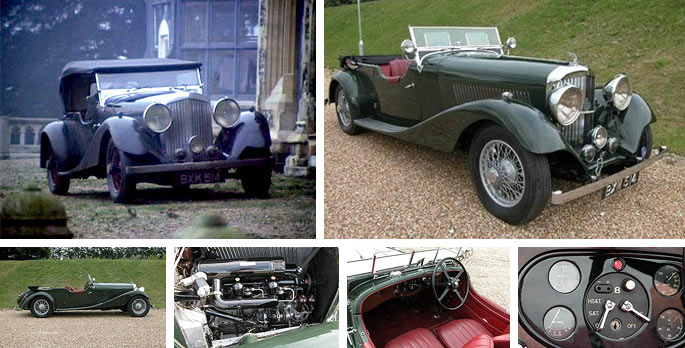
| |
|
Images © Anamera.com, 2008
except ITV Studios, 1968 (top left
image) |
|
|
-
We learn in this
episode that Marty can tell when the telephone is
about to ring, seconds before it actually does. We
also get an idea of how long he and Jeannie were
married, since he reminisces about his bachelor days
of "six or seven years ago". He is however, not
impressed when he finds Jeff in Jeannie's flat in
his pyjamas, with his wife. Jeannie,
meanwhile, reminds Jeff that the detective agency
has been running for about six years, so it would
seem that Marty married Jeannie and went into
business with Jeff at approximately the same time.
Knowing Marty, he would have seen the venture as a
way of providing financial security for himself and
his new wife.
-
Also, we see Jeff
trying to pawn some items, but the Foster brothers
pay the pawnbroker not to accept anything. However,
Jeff later manages to pawn the curtains and carpet
from his apartment.
-
At the start of
the episode, we find Jeannie reading The Penguin
Dictionary of Saints by Donald Attwater,
published in 1965. Undoubtedly this was an ITC
in-joke concerning the highly successful adventure
series The Saint, which had ceased
production after six years just prior to the
creation of Randall and Hopkirk (Deceased).
Annette Andre guest starred in five episodes of
The Saint, deepening the connection between the
two series.
-
This is one of
only four episodes in the series which doesn't
feature Jeff in a hand-to-hand fight with an
adversary. The other episodes that feature this
unusual turn of events are
Money to Burn,
The Ghost Who Saved the Bank at Monte Carlo and
The Ghost Talks. However, his luck hasn't
changed completely, as he has to fend off a
poltergeist attack in which he is faced with flying
ornaments, furniture and a sword with a life of its
own, and we also hear that, mirroring the Randall
and Hopkirk company cashflow, Jeff's own bank
account is in a bad way - he is £27 overdrawn.
Jeannie also points out that after six years, the
fact that he is still lunching in the local
Laundromat is a sure sign that the business has not
improved.
-
Only You, Jeff?
Henry Foster claims to be in contact with Marty and
tells Jeannie that he has a message from her late
husband. Marty is present when Foster makes this
claim and retorts that he is not in contact with
him, is completely unaware that he is there, and
that his message to Jeannie is that Foster is a
fraud. Needless to say, the message is not heard by
Foster, and not delivered to Jeannie!
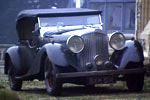 |
1934 Bentley
3½ Litre Low Door Vanden Plas Tourer
Registration BXM 514
Driven by Henry Foster |
|
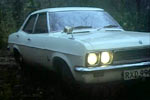 |
1968 Vauxhall
Victor FD 2000
Registration RXD 996F
Driven by Jeff Randall |
Also appeared
in:
Randall and Hopkirk (Deceased) -
used extensively throughout the series
Department S - 'The Last Train to
Redbridge', 'The Man from X' |
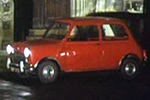 |
1964 Austin Mini Super Deluxe Mk I
Registration BAP 245B
Driven by Jean Hopkirk
|
Also appeared
in:
Randall and Hopkirk (Deceased) -
'My Late Lamented Friend and Partner', 'You Can
Always Find a Fall Guy', 'Never Trust a Ghost',
'Vendetta for a Dead Man', 'Just for the
Record', 'Could You Recognise the Man Again?', 'A
Disturbing Case', 'Somebody Just Walked Over My Grave',
'The Ghost Talks'
Department S - 'The Man from
X'
The Saint - 'The Time to Die'
The Persuaders! - 'Greensleeves' |
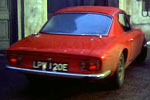 |
1967 Lotus
Elan Plus 2 (Type 50)
Registration LPW 120E
Driven by Laura Watson (not seen driving in
episode) and Henry Foster |
Also appeared
in:
Randall and Hopkirk (Deceased) -
'The Smile Behind the Veil'
Department S - 'The Last Train to
Redbridge' |
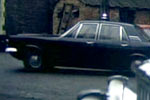 |
1967 Ford
Zephyr 4 Mark IV
Registration OLR 477E |
Also appeared
in:
Randall and Hopkirk (Deceased) - 'That's
How Murder Snowballs', 'Money
to Burn', 'The Man from Nowhere', 'The Ghost Talks' |
|
Images © ITV
Studios, 1968 |
-
Seen It All
Before? Another visit to the Elstree Studios
backlot, this time to one of the street sections,
here representing a yard area of the Fosters'
mansion. The sequence also features the 1967 Lotus
Elan Plus 2, registration number LPW 120E, last seen
being driven by Hilary Tindall as Cynthia Seaton in
The Smile Behind the Veil.
-
The Stanmore Hall location had previously been seen
in
The Trouble With Women as the base of the
Society of Spiritualists. Once wonders if the
Fosters were hosts and active members!
-
To represent the
interior of the Fosters' mansion, the hallway and
study sets, seen in most of the previous episodes of
the series in one form or another, were again
redressed.
-
Cock-ups... It takes
just 28 seconds for the first cock-up to present
itself, when Henry Foster pulls the car over
opposite Jean Hopkirk's flat. The sequence cuts from
an on-location shot on Lauderdale Road to an
in-studio shot against a painted backdrop. The style
of house depicted in the backdrop is not present on
Lauderdale Road and does not match the previous shot
at all.
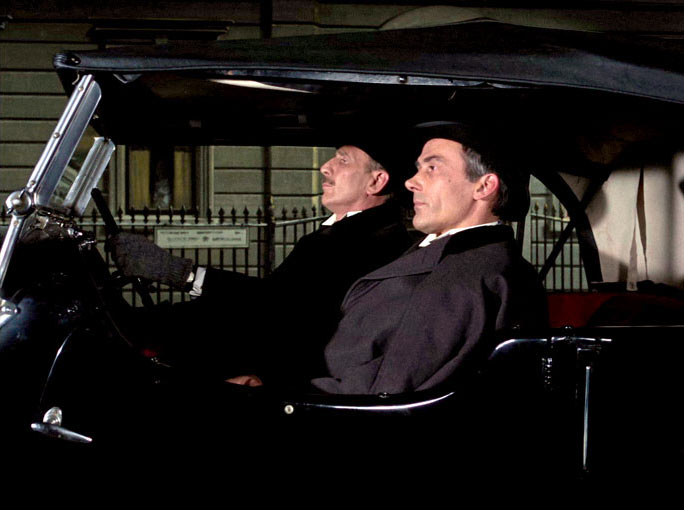 |
|
Image ©
ITV Studios, 1968 |
|
-
In the scene commencing at 1 minute and 5 seconds in
which Jean Hopkirk is subjected to a supposed
poltergeist visitation in her lounge, wires can be
seen in some shots depicting vases, tables, etc
being levitated. This is also the case with similar
happenings later in the episode at the Fosters'
mansion. These effects would have been
difficult to achieve without wires being visible on
Randall and Hopkirk (Deceased)'s
budget and with the technology of the time, and it
is to the credit of those working on the series that
the wires are often very hard to pick out even on
modern telecine transfers viewed on large screens.
-
At 1 minute and
33 seconds, as part of the
poltergeist attack, a small chair flies across the
room and smashes the protective glass screen of Jean's television
(not the actual tube), also moving the set back
several inches on its stand.
When we see it again a few seconds later, the
television is lacking the broken glass and it has
magically moved back to the fore edge of the stand!
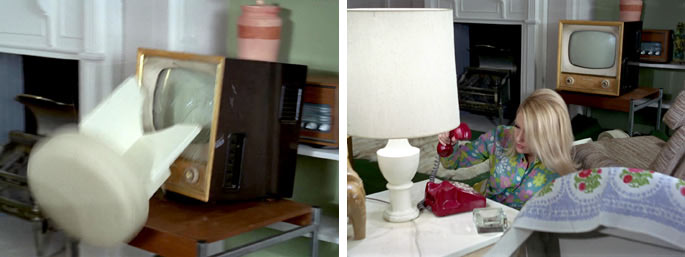 |
|
Images ©
ITV Studios, 1968 |
|
-
At 3 minutes and
11 seconds, we see Jeff in the Vauxhall, slamming on
the brakes. This is shot in studio against a blue
screen, but there is no street background optically
printed over the shot. This could simply be an
instance of cost-cutting. This is more noticeable on
the DVD print (where the shot appears at 3 minutes
and 3 seconds).
-
At 8 minutes and
16 seconds, when Jeff is eating his lunch at
the laundromat, we see Marty is sitting beside him,
but further back than Jeff. When the shot cuts to
the front, the pair are level. When the shot cuts
back to the side view, again they are staggered.
This is a compositional consideration, but still it
looks a little odd.
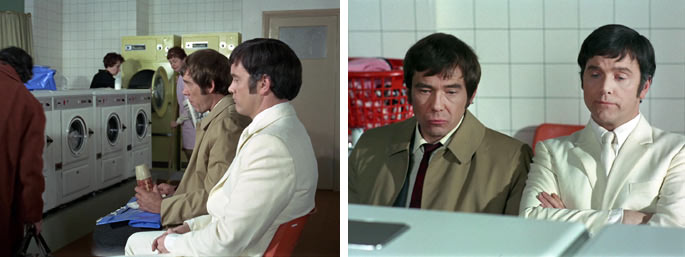 |
|
Images ©
ITV Studios, 1968 |
|
-
At 9 minutes and
53 seconds, Jeff drives Jeannie around four central
London streets - Charlotte Street, Goodge Street,
Tottenham Court Road and Grafton Way, all in W1.
However, due to the haphazard selection of optically
printed background footage from the World
Backgrounds BP 1009 reel, their journey actually
makes little geographical sense and we see the same
buildings going past the windows on a couple of
occasions. Was Jeff enjoying the conversation so
much that he was going around in circles? The route
is different for each:
-
Jeff's route is
Charlotte Street (opposite Scala Street) then down
Goodge Street to the junction with Whitfield Street.
We pick him up again after he has turned off
Tottenham Court Road onto Grafton Way.
-
Jeannie's route
is Charlotte Street past the Tottenham Street and
Scala Street intersections. She then turns on to
Goodge Street (twice!) and we then pick her up again
on Tottenham Court Road by the row of shops that
used to be between the deep level shelter entrance
and Lloyd's Bank.
We wouldn't
normally cry "cock-up" for backgrounds not making
real world geographical sense, but the repeated shots of the
same buildings land it slap bang in the middle of
cock-up territory!
-
At 12 minutes and
32 seconds, Jeannie turns into the Fosters' drive in
her Mini. In the wide shot she begins to turn left
off the road and the camera then cuts to a process
shot close-up of the inside of the car as she turns
the steering wheel and the reverse shot straightens
up. We then cut back outside and the car is pretty
much at the point it was at before she turns the
steering wheel.
-
At 12 minutes and 53 seconds,
Jeannie exits the Mini and goes to ring the Fosters'
doorbell. It is clearly an acting double and not
Annette Andrι and the stand-in has long blonde hair,
very curly at the neck (quite possibly a wig). When we cut to the
interior, Annette Andrι's hairstyle is a little shorter,
straighter and
styled upwards at the neck.
She also has a brick wall behind her outside the
front door which wasn't there on the location!
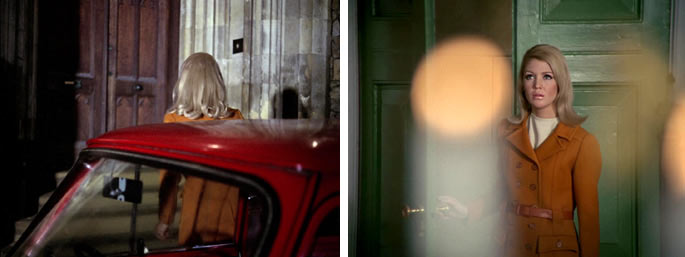 |
|
Images ©
ITV Studios, 1968 |
|
-
At 26 minutes and
50 seconds, the shadow of a moving boom microphone
can be seen on the upper part of the wall, swapping
left and right between Kenneth Cope and Mike Pratt
as their characters' conversation about Laura Watson plays out.
-
At 34 minutes and
17 seconds, we see Jeff ringing the Fosters'
doorbell as Jeannie had done previously. As in the
earlier scene, a brick wall has magically appeared
outside when George opens the door to him.
-
At 45 minutes and
58 seconds, Mike Pratt, having cut the electric cable
to the lock above the door at the Fosters' with the
sword, tries to swipe at lock itself and break it
off. He fails to make any impression, but then
continues as if he has!
Plotline: Scoton Productions / ITC UK
Transmissions by Simon Coward and Alan Hayes
Review by Alan Hayes Declassified by
Alan Hayes
with thanks to Vince Cox, Alys Hayes, John
Holburn, Corinna Hoptroff,
Anthony McKay and Andrew Pixley
All timings given on this page relate to the Blu-ray editions of this episode |
|
Back to
Programmes Index
Forward to
When the Spirit Moves You
Locations: All Work and
No Pay
|
|
|
Back to Top |
|



